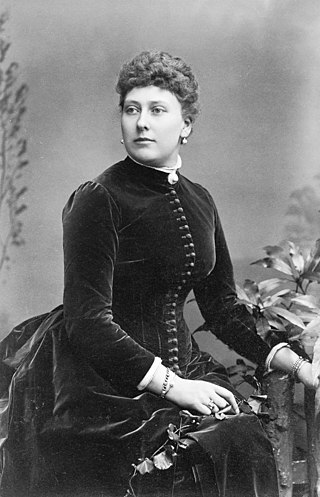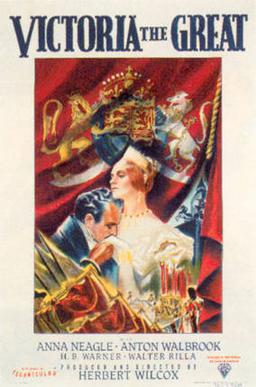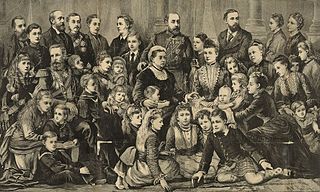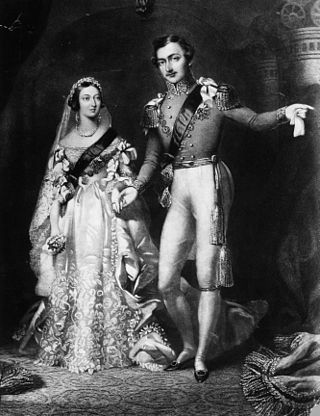
Mary of Teck was Queen of the United Kingdom and the British Dominions, and Empress of India, from 6 May 1910 until 20 January 1936 as the wife of King-Emperor George V.

Osborne House is a former royal residence in East Cowes, Isle of Wight, United Kingdom. The house was built between 1845 and 1851 for Queen Victoria and Prince Albert as a summer home and rural retreat. Albert designed the house himself, in the style of an Italian Renaissance palazzo. The builder was Thomas Cubitt, the London architect and builder whose company built the main facade of Buckingham Palace for the royal couple in 1847. An earlier smaller house on the Osborne site was demolished to make way for the new and far larger house, though the original entrance portico survives as the main gateway to the walled garden.

Prince Albert of Saxe-Coburg and Gotha was the husband of Queen Victoria. As such, he was consort of the British monarch from their marriage on 10 February 1840 until his death in 1861.

John Brown was a Scottish personal attendant and favourite of Queen Victoria for many years after working as a ghillie for Prince Albert. He was appreciated by many for his competence and companionship, and resented by others for his influence and informal manner. The exact nature of his relationship with Victoria was the subject of great speculation by contemporaries.

Prince Albert Victor, Duke of Clarence and Avondale, was the eldest child of the Prince and Princess of Wales. From the time of his birth, he was second in the line of succession to the British throne, but did not become king or Prince of Wales because he died before both his grandmother Queen Victoria and his father.

Prince Arthur, Duke of Connaught and Strathearn, was the seventh child and third son of Queen Victoria of the United Kingdom and Prince Albert of Saxe-Coburg and Gotha. He served as Governor General of Canada, the tenth since Canadian Confederation and the only British prince to do so.

Prince Leopold, Duke of Albany, was the eighth child and youngest son of Queen Victoria and Prince Albert. Leopold was later created Duke of Albany, Earl of Clarence, and Baron Arklow. He had haemophilia, which contributed to his death following a fall at the age of 30.

Princess Louise, Duchess of Argyll, was the sixth child and fourth daughter of Queen Victoria and Prince Albert.

Princess Beatrice, later Princess Henry of Battenberg, was the fifth daughter and youngest child of Queen Victoria and Prince Albert. Beatrice was also the last of Queen Victoria's children to die, nearly 66 years after the first, her elder sister Alice.

Frogmore is an estate within the Home Park, adjoining Windsor Castle, in Berkshire, England. It comprises 33 acres (130,000 m2), of primarily private gardens managed by the Crown Estate. It is the location of Frogmore House, a royal retreat, and Frogmore Cottage. The name derives from the preponderance of frogs which have always lived in this low-lying and marshy area near the River Thames. This area is part of the local flood plain. Its large landscaped gardens are Grade I listed on the Register of Historic Parks and Gardens.

Sir Joseph Edgar Boehm, 1st Baronet, was an Austrian-born British medallist and sculptor, best known for the "Jubilee head" of Queen Victoria on coinage, and the statue of the Duke of Wellington at Hyde Park Corner. During his career Boehm maintained a large studio in London and produced a significant volume of public works and private commissions. A speciality of Boehm's was the portrait bust; there are many examples of these in the National Portrait Gallery. He was often commissioned by the Royal Family and members of the aristocracy to make sculptures for their parks and gardens. His works were many, and he exhibited 123 of them at the Royal Academy from 1862 to his death in 1890.
Major General Sir Howard Craufurd Elphinstone, was a British Army officer and a recipient of the Victoria Cross, the highest award for gallantry in the face of the enemy that can be awarded to British and Commonwealth forces.

Franz Xaver Winterhalter was a German painter and lithographer, known for his flattering portraits of royalty and upper-class society in the mid-19th century. His name has become associated with fashionable court portraiture. Among his best known works are Empress Eugénie Surrounded by her Ladies in Waiting (1855) and the portraits he made of Empress Elisabeth of Austria (1865).

The Royal Alexandra and Albert School is an all-through co-educational boarding school near Reigate, Surrey. The headmaster as of 2022 is Morgan Thomas. The Royal Alexandra and Albert School Act, of 1949, united The Royal Alexandra School, which was founded in 1758, and The Royal Albert orphan School, which was founded in 1864 as a national memorial to Prince Albert, late husband of Queen Victoria. It is one of 36 state-maintained boarding schools in England and Wales, and the only one to educate children from primary school years to sixth form.

Victoria the Great is a 1937 British historical film directed by Herbert Wilcox and starring Anna Neagle, Anton Walbrook and Walter Rilla. When Laurence Housman's play Victoria Regina was banned by the Lord Chamberlain, its subsequent Broadway success prompted King Edward VIII to commission producer Herbert Wilcox to turn it into a film, commemorating the centenary of Victoria's reign. The film biography of Queen Victoria concentrates initially on the early years of her reign with her marriage to Prince Albert and her subsequent rule after Albert's death in 1861. It was released in the year of Victoria’s great-grandson King George VI's coronation, which was also the centennial of Victoria's own accession to the throne. The movie was so successful that a sequel appeared the following year, Sixty Glorious Years.

Queen Victoria, the British monarch from 1837 to 1901, and Prince Albert had 9 children, 42 grandchildren, and 87 great-grandchildren.

The wedding of Prince Albert, Duke of York and Lady Elizabeth Bowes-Lyon took place on 26 April 1923 at Westminster Abbey. The bride was a member of the Bowes-Lyon family, while the groom was the second son of King George V.

Queen Victoria of the United Kingdom married Prince Albert of Saxe-Coburg and Gotha on 10 February 1840. She chose to wear a white wedding dress made from heavy silk satin, making her one of the first women to wear white for their wedding. The Honiton lace used for her wedding dress proved an important boost to Devon lace-making. Queen Victoria has been credited with starting the tradition of white weddings and white bridal gowns, although she was not the first royal to be married in white.

The Royal Mausoleum is a mausoleum for Queen Victoria and her husband Prince Albert, Prince Consort. It is located on the Frogmore estate within the Home Park at Windsor in Berkshire, England. It was listed Grade I on the National Heritage List for England in October 1975. Built between 1862 and 1871, Albert, who died in 1861, was interred in the mausoleum in 1871 following its completion. Victoria was interred on 4 February 1901 following her death in late January.


















